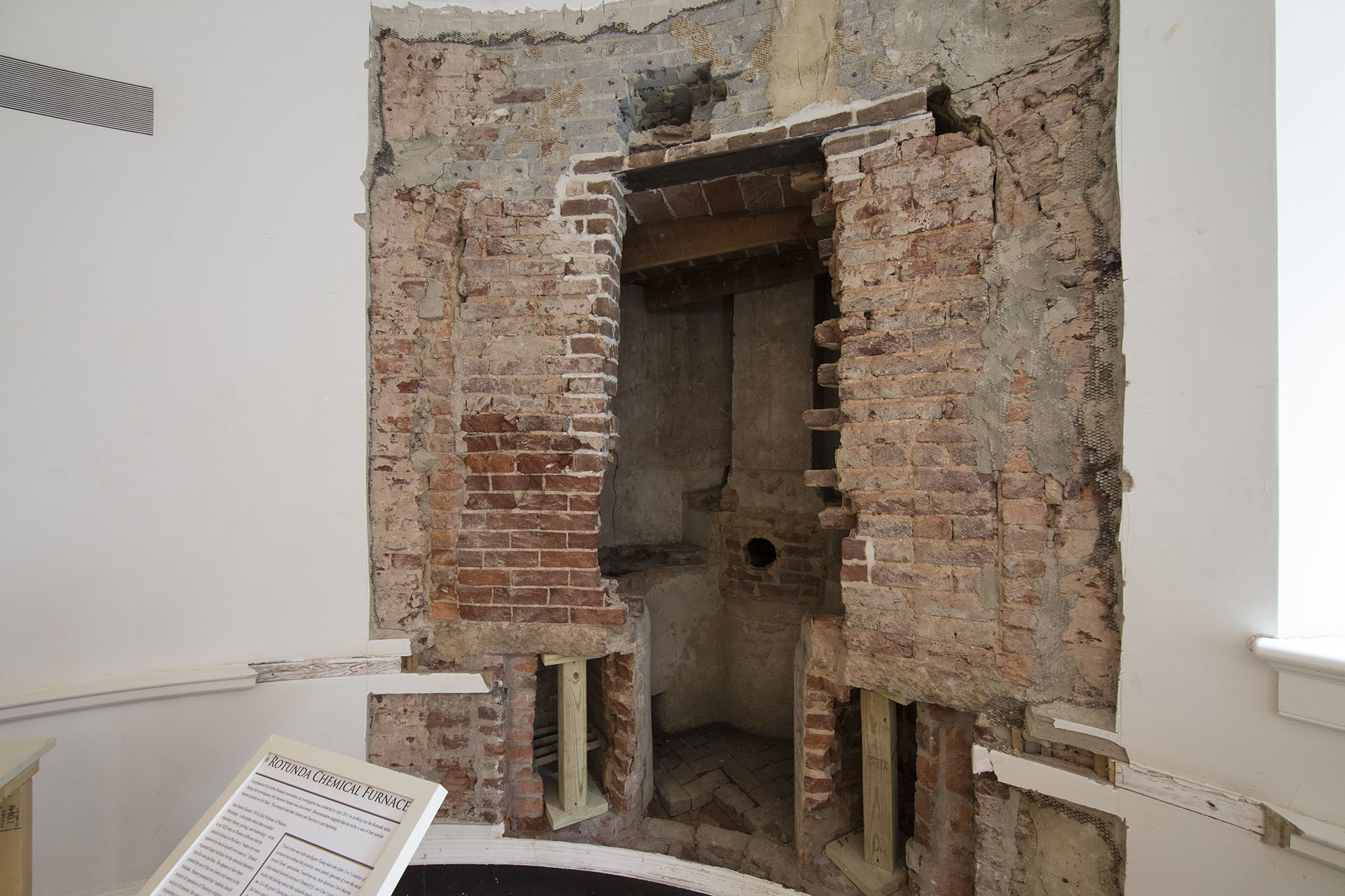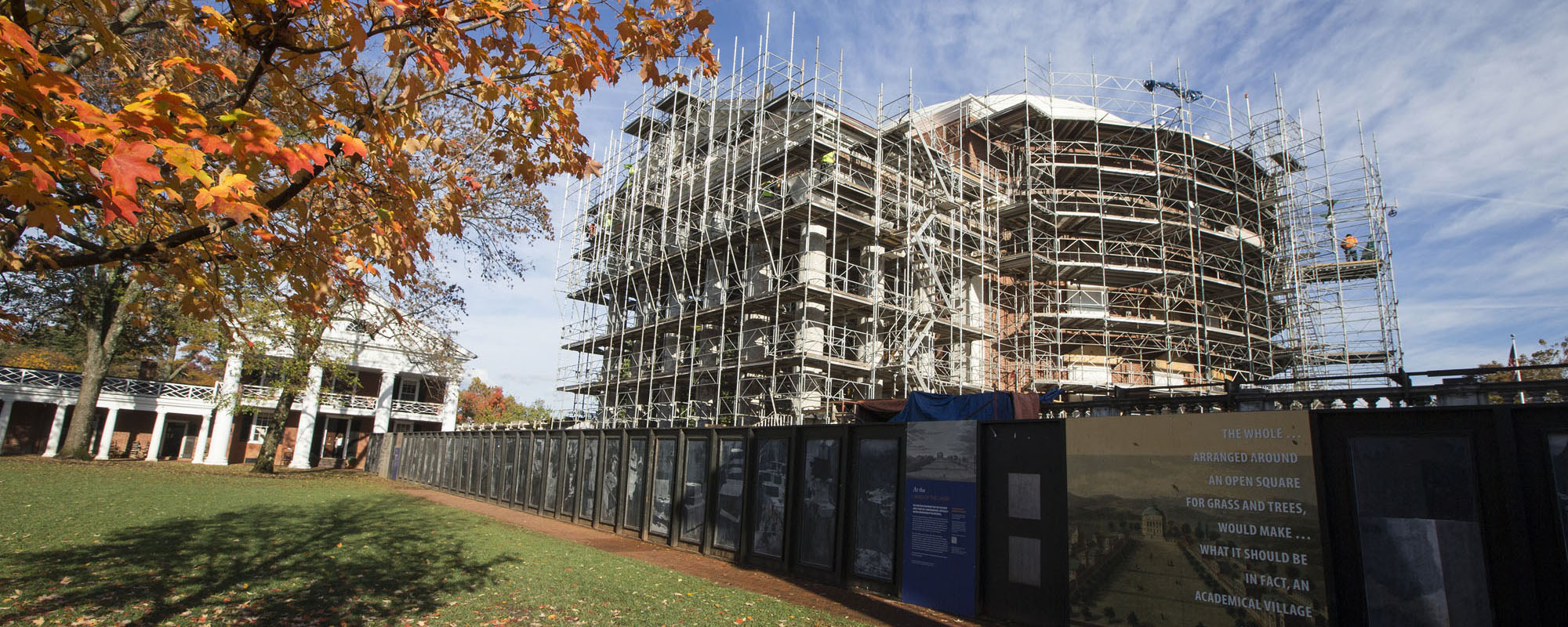While it has been the center of the University of Virginia for nearly 200 years, the Rotunda still has some surprises.
Since the two-year renovation started, conservators have found pieces of the original Rotunda dome, dug up a cistern, and uncovered a chemical hearth that dates back to John Emmet, the University’s first science professor.
And while some historical artifacts were discovered, others were replaced. Italian craftsmen carved new marble capitals to top the columns that hold up the portico roofs, recreating University founder Thomas Jefferson’s original look. And a historic design will be used for the new aluminum clock face that will cover and protect the original one.
The chemical hearth, part of an early science classroom, had been sealed into one of the lower-floor walls of the Rotunda since the 1840s, and thus was protected from the 1895 fire that damaged much of the building’s interior. Two small fireboxes for the hearth were uncovered in a 1970s-era renovation, but the hearth itself remained hidden until the current project.
Architect Matt Scheidt, a project manager for John G. Waite Associates of Albany, New York, which specializes in historic buildings, examined one of the fireboxes and decided there was more there.
“It was a surprise, a very exciting one for us,” said Brian Hogg, senior historic preservation planner in the Office of the Architect for the University. “This may be the oldest intact example of early chemical education in this country.”

The Rotunda chemical hearth provides a look at what early science education on Grounds was like.
The chemical hearth was built as a semi-circular niche in the north end of the Lower East Oval Room. The two fireboxes provided heat (one burning wood for fuel, the other, coal); underground brick tunnels fed fresh air to fireboxes and workstations; and flues carried away the fumes and smoke. Five workstations were cut into stone countertops.
“Back then, the different experiments would get different levels of heat from different sources,” said Jody Lahendro, a supervisory historic preservation architect for UVA’s Facilities Management. “For some, they would put the heat source under a layer of sand to more evenly disperse and temper the heat.”
The chemical hearth may have been closed up in the wall in the mid-1840s when the chemistry laboratory was moved to the southwest wing of the Rotunda. The labs were later moved to the basement of the Rotunda Annex, which was built in the 1850s, then destroyed in the 1895 fire.
“The hearth is significant as something of the University’s early academic years,” said Mark Kutney, an architectural conservator in the University Architect’s office. “The original arch above the opening will have to be reconstructed, but we hope to present the remainder of the hearth as essentially unrestored, preserving its evidence of use.”
The hearth is not the only historical find linking directly back to Jefferson. Conservators examining cavities behind the walls of the Lower West Oval Room found debris from the 1895 fire that included fragments of the original Rotunda dome.
“We found a lot of glass, window glass, melted and broken into pieces, and we found pieces of sheet tin that appear to be material from the roof,” Kutney said.
The shingle pieces Kutney found in the wall cavities were joined together with folded-over edges, a technique designed by Jefferson and used on several roofs within the Academical Village. The original, tin-clad dome would have started off shiny, but then would have turned a dull gray, eventually weathering to a chalky white.
Some of the surviving shingles had red paint on them, indicating that at some point before the fire the dome was painted red. Rotunda photographs from the 1880s depict a darker dome; in black-and-white photographs, red appears as a darker shade.
Some of the newly discovered shingle pieces appear to have been painted on both sides. Scheidt suggested the dome may have been re-shingled at some point, with the second layer already painted on both sides as a protective coating.
“These shingles are ones that were on the dome right before the fire,” Scheidt suggested. “If they put a new roof on, they would likely have put over the existing one, so it is possible that some of the original roof survived.”
Pieces of the original column capitals – carved from Carrara marble, at Jefferson’s direction – also survived the fire. When, after the fire, architect Stanford White re-envisioned the Rotunda, he commissioned capitals of domestic marble. After 115 years, those capitals were crumbling.
Craftsmen from the Pedrini Sculpture Studio in Carrara laser-scanned the remains of the largest surviving original capital, which was about 75 percent complete. Coupling these scans with drawings and photographs of the original capitals, they sought to recreate the Jeffersonian design.
The new capitals – about 90 percent of which were carved by machine, and finished off by hand – weighed 6,300 pounds apiece. Workers carefully installed them using a custom-designed structure with a steel trolley that carried the capitals to their spots under the portico.
The Rotunda clocks, centerpieces of the north and south porticos, will be replaced, with the old clock works preserved. In the post-fire Rotunda, White installed devices from E. Howard and Co., clockmakers of Boston, into the south portico, replacing Jefferson’s original clock, and in the newly created north portico. In the current renovation, workers will install new hands and dials, replicating the Howard design, and the new dial will encapsulate and preserve the old clock face – perhaps to be rediscovered decades from now in another renovation.
Media Contact
Article Information
October 29, 2015
/content/rotunda-still-offering-gems-its-history

